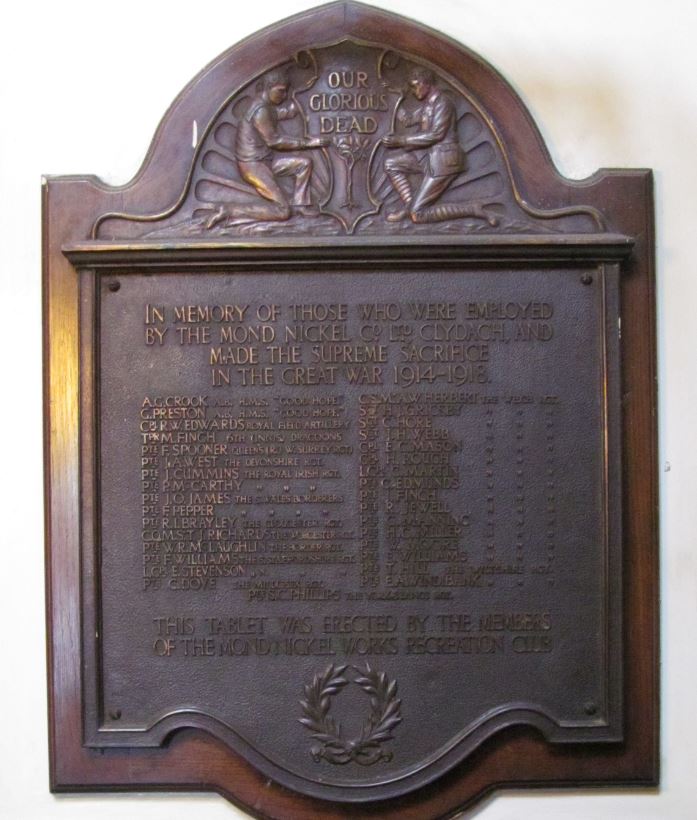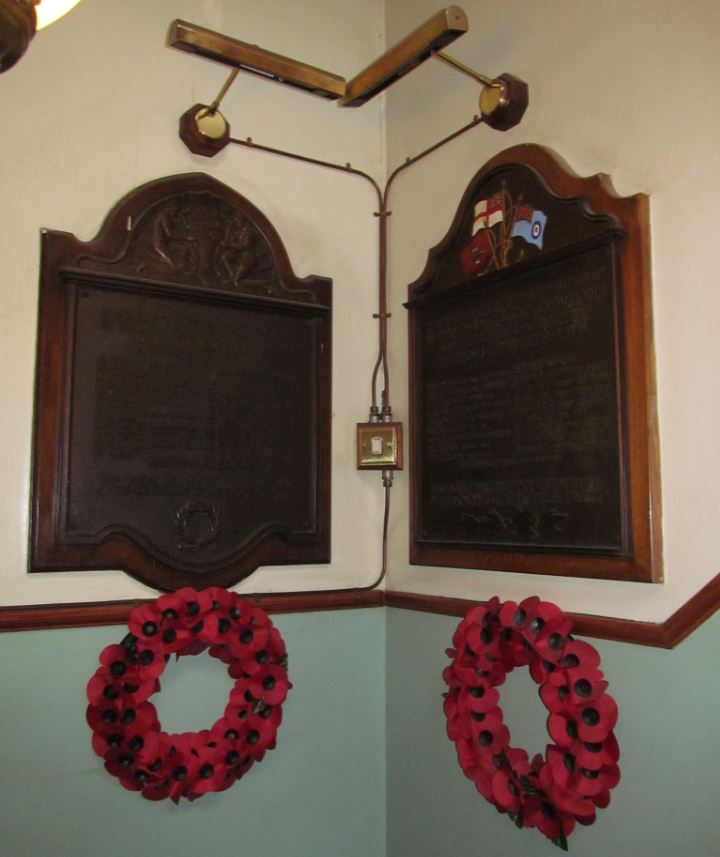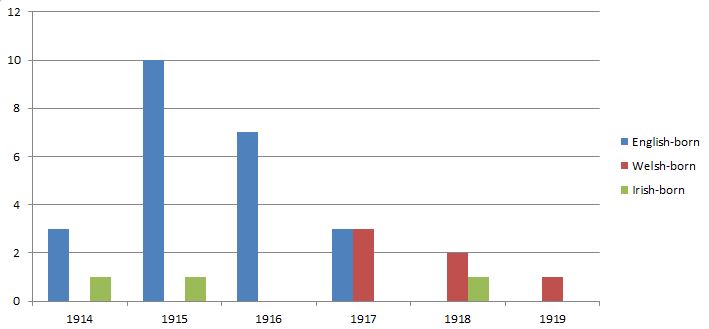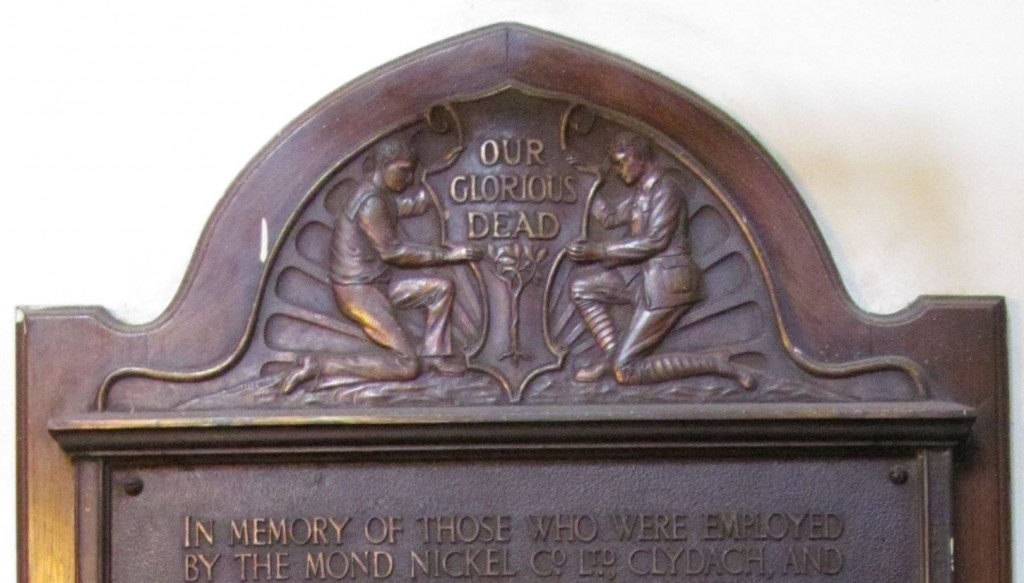The Mond Nickelworks WW1 Memorial
For well over a century, the Mond nickelworks has been a major landmark and an important employer for the people of Clydach, in the lower Swansea valley. The works first produced nickel in 1902, using a process pioneered by a German chemist-entrepreneur named Ludwig Mond whose statue stands nearby, surveying his creation. Although the ownership of the works has changed over the decades, so that it is now operated by Vale, a Brazilian company, to locals it is simply ‘the Mond’.
On the way into the Mond Community Centre (attached to the works) you walk past two memorials, commemorating the 33 men associated with the company who died in the First World War, and the 19 who were killed in the Second World War.
The number of names on the WW1 memorial is striking, although it is only a fraction of the 450 Mond employees who volunteered or (after 1916) were conscripted into the armed services. The figures indicate that 250 employees (out of 850) volunteered to serve in the Armed Forces in the first few months of the war. Besides any other reasons for volunteering, they were encouraged and supported by the company’s management, who promised to pay half-wages to the families of married volunteers, and also to support the dependents of single men who joined up. Of course, the product of the Mond, refined nickel, was in high demand at wartime and it was a profitable time for the company. For more details of this, see this blog from 2014 on the BBC’s website.
One consequence of the flow of men from the Mond into uniform was that women were recruited to work in the manufacturing process for the first time: thus the list of names on the memorial is only part of the story of how the war affected the local community.
Excellent research work by local historian Bill Hyett into the details of the 33 men who died shows some interesting patterns that need to be carefully examined and explained.  Mr Hyett has found biographical and service details of all but one of the men. The statistic that stands out from this research is that over two thirds of them – 23 – were English-born. A further three were Irish-born, meaning that only six were Welsh-born. This does not reflect the general workforce at the Mond, where the majority of the names on the employment register are clearly Welsh.
Mr Hyett has found biographical and service details of all but one of the men. The statistic that stands out from this research is that over two thirds of them – 23 – were English-born. A further three were Irish-born, meaning that only six were Welsh-born. This does not reflect the general workforce at the Mond, where the majority of the names on the employment register are clearly Welsh.
A clue to explain this discrepancy can be found when studying the patterns of when these servicemen were killed. Of the four who died in 1914,three were English and one Irish; in 1915, ten English and one Irish were killed; all of the seven casualties in 1916 were English-born. Then in 1917 three English-born and three Welsh-born died; in 1918 two Welsh and one Irish and the final casualty, who died in 1919, was Welsh.
This demonstrates that most of those who joined up earliest in the war, and who were thus most likely to be killed in it, were English-born. Most of these had lower-paid unskilled jobs at the plant, and some had not been working there very long. One example is Reginald Edwards, born at Erdsley, Hereford. His employment at the Mond was very brief, as he started work on 11 August 1914 and volunteered for the Royal Field Artillery in September 1914. Thus those who were most likely to join up early in the war were the unskilled labourers, many of whom had moved to Clydach from England. The local-born workers often had better-paid, higher-skilled jobs, and so were less likely to volunteer for the armed forces.
Here are details from Mr Hyett’s magnificent research of two individuals which give an idea of the human stories behind the list of names on the metal plaque. The first of the Mond casualties was Tipperary-born Peter McCarthy, who was about 25 years old when he began work at the Mond in March 1914. He must have been an army reservist, called up in August 1914, for he was killed on the Western Front on 7 October 1914: he has no known grave.
The final Mond casualty was Sidney Phillips (noted on the memorial as S. C. Phillips, though Mr Hyett’s research has shown that his middle name was George). He was Swansea-born and lived in Ebenezer Street, Swansea with his wife and three children. Sidney was one of those who volunteered in 1914, initially serving with the Welsh Regiment before transferring to the York and Lancs Regiment. He suffered a gun-shot wound to the thigh in May 1916 but recovered, only to fall victim to a gas attack in France. He was invalided home and discharged from the army in September 1918, but died on 17 April 1919 and received a military funeral in Swansea’s Dan-y-Graig cemetery.
g.h.matthews May 23rd, 2016
Posted In: Uncategorized




